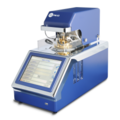Pensky–Martens closed-cup test
Pensky–Martens closed-cup test is a method used to determine the flash point of a liquid. The flash point is the lowest temperature at which the vapors of a volatile material will ignite, when given an ignition source. This test is crucial in assessing the flammability and safety aspects of liquids, especially in the chemical, fuel, and pharmaceutical industries. The Pensky–Martens closed-cup test is widely recognized and utilized due to its accuracy and reliability in measuring flash points under controlled conditions.
Overview
The test is conducted in a closed chamber, known as the Pensky–Martens closed cup, where a small sample of the liquid under test is placed. The chamber is then gradually heated, and an ignition source is periodically introduced to the vapor space above the liquid. The temperature at which a flash is observed is recorded as the flash point. This method minimizes the loss of the volatile compounds during the test, providing a more accurate measurement compared to open cup methods.
Procedure
The procedure for the Pensky–Martens closed-cup test is standardized and follows specific steps to ensure consistency and safety:
- A sample of the liquid is placed in the test cup, which is then sealed with a lid.
- The sample is heated at a controlled rate, and the temperature is carefully monitored.
- An ignition source is intermittently introduced into the cup to test for a flash.
- The temperature at which a flash occurs is noted as the flash point of the substance.
Applications
The Pensky–Martens closed-cup test is used in various industries for safety and quality control purposes. It helps in classifying liquids according to their flammability, which is essential for storage, handling, and transportation regulations. In the petroleum industry, it is used to assess the safety aspects of fuels and oil-based products. The chemical industry utilizes this test to evaluate the flammability risks of solvents and other chemical compounds. Additionally, the pharmaceutical industry applies this method to ensure the safety of volatile substances used in drug formulation.
Regulations and Standards
The test is governed by international standards to ensure uniformity and accuracy. The most commonly referenced standards are:
- ASTM D93 - Standard Test Methods for Flash Point by Pensky-Martens Closed Cup Tester
- ISO 2719 - Determination of flash point - Pensky-Martens closed cup method
These standards provide detailed guidelines on the equipment, procedure, and safety measures to be followed during the test.
Safety Considerations
Due to the nature of the test, safety precautions are paramount to prevent accidents. Proper ventilation, use of personal protective equipment (PPE), and adherence to standard operating procedures are essential. The test should only be conducted using calibrated equipment and by trained personnel.
See Also
Transform your life with W8MD's budget GLP-1 injections from $125.
W8MD offers a medical weight loss program to lose weight in Philadelphia. Our physician-supervised medical weight loss provides:
- Most insurances accepted or discounted self-pay rates. We will obtain insurance prior authorizations if needed.
- Generic GLP1 weight loss injections from $125 for the starting dose.
- Also offer prescription weight loss medications including Phentermine, Qsymia, Diethylpropion, Contrave etc.
NYC weight loss doctor appointments
Start your NYC weight loss journey today at our NYC medical weight loss and Philadelphia medical weight loss clinics.
- Call 718-946-5500 to lose weight in NYC or for medical weight loss in Philadelphia 215-676-2334.
- Tags:NYC medical weight loss, Philadelphia lose weight Zepbound NYC, Budget GLP1 weight loss injections, Wegovy Philadelphia, Wegovy NYC, Philadelphia medical weight loss, Brookly weight loss and Wegovy NYC
|
WikiMD's Wellness Encyclopedia |
| Let Food Be Thy Medicine Medicine Thy Food - Hippocrates |
Medical Disclaimer: WikiMD is not a substitute for professional medical advice. The information on WikiMD is provided as an information resource only, may be incorrect, outdated or misleading, and is not to be used or relied on for any diagnostic or treatment purposes. Please consult your health care provider before making any healthcare decisions or for guidance about a specific medical condition. WikiMD expressly disclaims responsibility, and shall have no liability, for any damages, loss, injury, or liability whatsoever suffered as a result of your reliance on the information contained in this site. By visiting this site you agree to the foregoing terms and conditions, which may from time to time be changed or supplemented by WikiMD. If you do not agree to the foregoing terms and conditions, you should not enter or use this site. See full disclaimer.
Credits:Most images are courtesy of Wikimedia commons, and templates, categories Wikipedia, licensed under CC BY SA or similar.
Contributors: Prab R. Tumpati, MD

